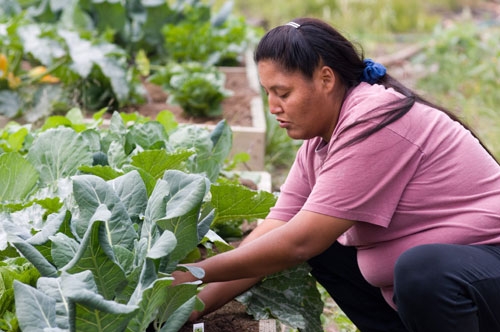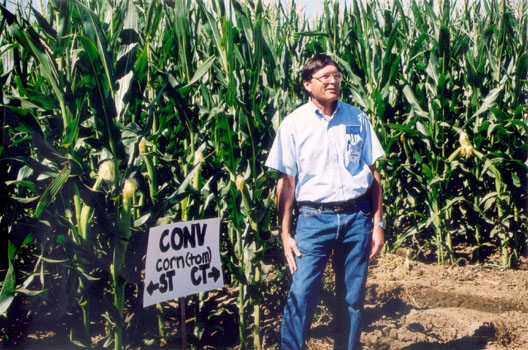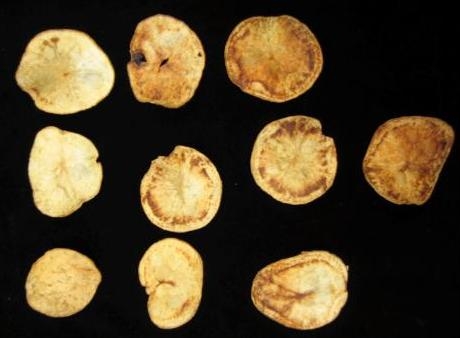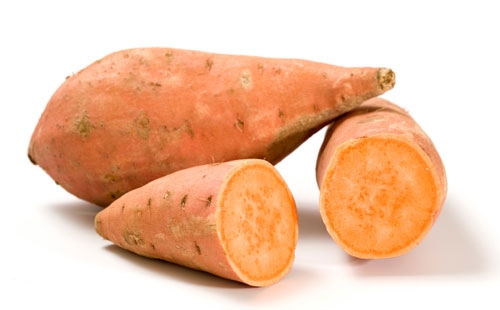Posts Tagged: potatoes
Kent Brittan, UC Cooperative Extension advisor, retires after nearly 34 years
For the past 17 years, Brittan was a UC Cooperative Extension advisor for Yolo, Solano and Sacramento counties and director of UC Cooperative Extension in Yolo County.
“Kent has been a great resource in Yolo County,” said Richard Rominger, a long-time grower in Winters and deputy secretary of the U.S. Department of Agriculture during the Clinton Administration.
Over a number of years, Rominger and his sons have provided Brittan with plots of land for studying different varieties of wheat, barley, oats and triticale, a cross between wheat and rye. In addition to small grains, Brittan also had variety trials for corn, safflower, canola and sunflower seed production in other parts of Yolo County and in Solano and Sacramento counties to see how the different varieties grew in different soil and climate conditions, which were more disease resistant or showed desirable qualities for making flour, oil or seed. He was instrumental in starting triticale grain production in Northern California.
“Kent has been a resource not only to us, but other farmers as well,” Rominger explained. “They could come by to see the comparisons of different varieties. He would hold field days and tell us what we needed to be planting in two to three years.”
Brittan studied insects at San Jose State University, where he earned a bachelor’s degree in biology in 1977. After graduation, Brittan began his career with UC Cooperative Extension as a staff research associate studying cotton at the USDA Cotton Research Station in Shafter. At a time when over a million acres of cotton were grown in California, he did research on pink bollworm, plant growth regulators and narrow row planting.
During his high school years, Brittan had had a summer job loading sacks of potatoes. Later, while doing research for UC Cooperative Extension on potato varieties grown in Eureka, Tule Lake, Half Moon Bay, Santa Maria and Kern County, he found himself hoisting 100-pound sacks of potatoes again.
“I used to know how many millions of pounds of potatoes I moved by hand,” Brittan said, chuckling. He explained that to evaluate the potatoes, more than 100 of the 100-pound bags had to be moved five or six times – from the field to the truck, from the truck to the shed, from the shed to grading tables, then back to the truck to put in cold storage and then out again to be cut for seed.
“We did this at two locations every year and had three other locations with 15 to 20 sacks,” he noted.
“A sack of potatoes is an ungainly thing to move because the contents move as you pick it up,” he observed. “The amazing thing is I still have a good back.”
“I worked with every color of potato you can imagine,” said Brittan, who shares a plant variety patent for a fresh white potato. With knowledge acquired from years of evaluating potato varieties, Brittan was part of a group of potato experts that advised McDonald’s on the best chipping variety to make into french fries.
In 1995, he earned a master’s degree in vegetable crops at UC Davis, doing his thesis on the effects of salinity on processing tomato production. “My family thought that was really funny because I didn’t like to eat fresh tomatoes,” Brittan said.
Brittan coordinated processing-tomato research, evaluating tomato varieties to select those that make the finest tomato paste.
“There’s a reason why California is a world leader, producing more than one-third of the tomato paste in the world and UC Cooperative Extension is it,” Brittan said with pride.
As he reflected on his career, Brittan said, “With UC, I’ve had the ability to work with so many different people and have an impact on many different things.”
Brittan authored or co-authored 16 peer-reviewed articles, 58 non-peer-reviewed articles and five cost-of- production studies. In addition, he’s studied garlic, onions, bell peppers, artichokes, asparagus and sweet potatoes, crops that aren’t commercially grown outside of California. When growers were losing over a million ears of corn to ear rot, he began screening the plant material and losses to the disease consequently dropped from 30 percent to less than 2 percent.
Yolo County grower Rominger lamented the loss of Brittan’s expertise.
“He was always available,” Rominger said. “If we had questions we could call him up. Those are the kind of people Cooperative Extension is losing to retirement. They provide a lot of information for farming.
“The extension service is really valuable. It’s one reason we have outstanding agriculture around California and the U.S. It’s something we don’t want to lose.”
Brittan has been granted emeritus status so he may continue small grains research, but is keeping his options open for retirement activities. Although agriculture has provided his living, Brittan said he may pursue his interests in photography and mass transit trains.
Potato chips: going, going … not gone!
It’s easy to finish half a bag of chips, or more, while being spread out on a couch, watching TV, the remote near and handy. So robotic can such chip consumption be that it’s easy, too, not to glance at the chip parade traveling resolutely from bag to mouth. But glance we must, for had it not been for the work of a research team, those healthy potato chips for most of us today would be out of reach and pricey, crunched into a crisp footnote in potato history.
The research team, which rescued the potato chip industry from major losses, is the “Zebra Chip Research Team.” It has just won the Integrated Pest Management Team Award from the Entomological Foundation, a national organization that aims to educate young people about science through insects. The foundation recognized the team for its research and extension efforts that have had a dramatic effect on the potato industry.
John Trumble, a distinguished professor in the Department of Entomology at the University of California, Riverside, is a member of the Zebra Chip Research Team. He explained that by the time the team formed in 2008, a new pathogen had devastated the potato industry by spreading zebra chip disease, causing losses in the millions of dollars annually (see Q&A below).
“Indeed, many growers were on the verge of leaving the industry entirely,” he said. “When pesticide use in the fields increased dramatically, with unsatisfactory results, more economic losses followed.”
The Zebra Chip Research Team developed new techniques to identify the pathogen, allowing researchers to document local, regional, and national movements of the potato psyllid (Bactericera cockerelli) spreading zebra chip disease. The researchers determined both within-plant and within-field movements of the psyllid and the zebra chip pathogen, and developed special sampling programs that enabled potato growers to choose the level of risk they were willing to accept.
The sampling programs accurately determined the efficacy of pesticides and the benefit of available biological control agents. They also documented a variety of alternatives to unsustainable pesticide use. Through websites, effective outreach practices, and grower and scientific meetings, the Zebra Chip Research Team promoted a sustainable integrated program that today allows the industry to continue to produce potatoes while making a profit and minimizing potential negative effects for the environment.
Besides Trumble, the following researchers are members of the Zebra Chip Research Team: Charlie Rush, an epidemiologist at Texas A&M University; Neil Gudmestad, a plant pathologist at North Dakota State University; Gerhard Bester of Frito Lay; Casey Butler of Syngenta Crop Protection; Joe Munyaneza, an entomologist, and Jim Crosslin, a plant pathologist, at USDA-Agricultural Research Service, Yakima, Wash.; Jon Goolsby, an entomologist at USDA-Agricultural Research Service, Edinburgh, Texas.; Don Henne, a horticultural scientist at Texas Agrilife Research, Weslaco; and Fekede Workneh, a plant pathologist at Texas Agrilife Research, Bushland.
Congratulations to them all for their work on zebra chip disease and the recognition they received from the Entomological Foundation!
Q&A with Trumble:
Where in the country is the disease affecting potatoes?
Arizona, California, Colorado, Kansas, Nebraska, Nevada, Oregon, New Mexico, Texas, and Washington State. Problems have now been reported throughout California, including Riverside County, Kern County and Ventura County. We find it in our experimental plantings in Orange County.
What kind of economic loss has zebra chip disease caused?
In the 2004-06 growing seasons, Texas growers estimated losses at over $25 million. Many growers during and since then have abandoned fields, with Texas reporting about a 20% reduction in planting. Guatemala, Honduras and New Zealand have reported over 80% of plants infested and losses of nearly all marketable size tubers. Dollar losses in California have not been estimated, but growers throughout the USA dramatically increased pesticide applications, which greatly increased production costs. Much of the Team's efforts were designed to determine how to economically control the pest. We did this by minimizing or eliminating use of the class one (highly toxic) pesticides, developing control strategies with low environmental impact and high economic return for the investment, and increasing use of beneficial insects.
Urban agriculture: An old model made new
Yesterday, I moderated a panel on urban agriculture at the annual meeting of the California Planning Association, which was held in Santa Barbara. The room was packed: urban agriculture is a hot topic these days. Micro-farms, backyard chickens, bee keeping, raw food markets all present challenges – and opportunities - for planners and communities. In our discussions yesterday, the idea of “scale” and definition came up frequently. The consensus of the panel? Within urban areas, urban agriculture should encompass everything from backyard gardens to commercial agricultural operations.
In practice, urban agriculture has been a persistent and organized activity in urban areas for well over a century. And one could argue that places like The Common in Boston make “urban agriculture” an even older model. Farming on the urban fringe - or even in the urban core, at some scale - has long been a feature of American life. Farmers markets are not a new feature of American life; they represent one of the oldest models of food distribution … from farmer direct to consumer.
The Panic of 1893, an economic downturn that brought distress to both urban and rural populations, was particularly difficult on Americans; there were few social safety nets for the poor and destitute. (Programs like Social Security and the Supplemental Nutrition Assistance Program – food stamps – came much, much later). The Panic of 1893 created a dangerous social climate in America, particularly in urban areas teeming with unemployed factory workers. The crisis brought to the fore a model of relief gardening that quickly took hold across the United States.
The “Potato Patch Farms” model, also called the “Detroit Experiment,” emerged under the leadership of Detroit’s mayor, Hazen Pingree. Pingree’s model connected hundreds of acres of vacant land in Detroit with unemployed workers and their families, who were provided with the materials, tools and education to garden the unused land. This was done in a systematic fashion. Pingree’s idea of ethical relief was met with strong resistance from many who believed that the unemployed – many of them immigrants – were too lazy to work. Skeptics, of course, were wrong: 3,000 families applied for the 975 allotments available the first year of the program (1894). The program grew during the next two seasons (1,546 families participated in 1895, 1,701 families gardened in 1896).
The city’s agricultural committee kept records of the investments made into the program and the value of crops harvested. In 1896, the value of food produced in Detroit’s potato patches was greater than the money provided to needy citizens by the “poor commission.”
The idea quickly spread to other urban areas: New York City, Buffalo, Philadelphia, Boston and Seattle were among the nineteen cities sponsoring vacant lot projects on some scale, according to an 1898 report. The model Pingree developed in Detroit was particularly innovative and visionary for its time; by the early 1900s, there was a national vacant lot cultivation organization that encouraged urban agriculture and city gardening. These programs clearly provided a rationale for the cultivation of vacant lots – “slacker land” - during the Liberty/Victory Garden effort in World War I.
To this historian, today’s economic climate feels quite a lot like 1893. And urban agriculture is once again coming to the fore as a viable, necessary and welcome addition to the food landscape. Detroit and many, many other urban areas, faced with issues created by depopulation, high unemployment, food deserts and other enormous challenges, are again looking at urban agriculture to provide solutions.
I applaud the dozens of planning professionals who attended this session, engaging in iterative discussions with panelists and other participants. These planners will play a vital role in creating public policies that support healthy and resilient food systems in our communities ... policies that acknowledge that increasingly, communities want more explicit connections with their food.

Micro-farms, backyard chickens, bee keeping and raw food markets are popular forms of urban agriculture.
More sweet potatoes growing in California
A hungry pest is devouring San Diego County oak trees
Tony Perry, Los Angeles Times
The goldspotted oak borer is devouring enormous numbers of oak trees in San Diego County and its devastation could spread to trees throughout California, according to researchers at UC Riverside. "This may be the biggest oak mortality event since the Pleistocene [epoch] 12,000 years ago," UC Riverside natural resource specialist Tom Scott said in a report issued last week. The Times story was prompted by a UC Riverside news release.





